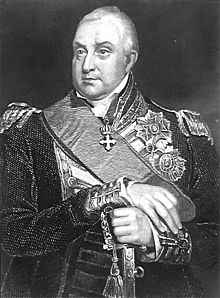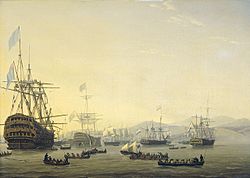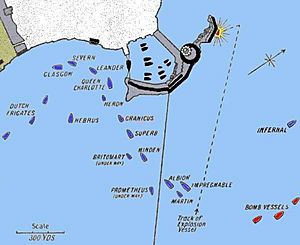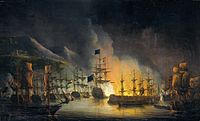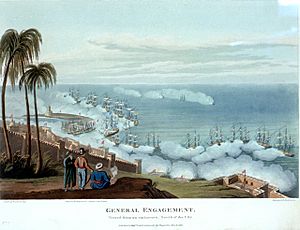Bombardment of Algiers (1816) facts for kids
Quick facts for kids Bombardment of Algiers |
|||||||
|---|---|---|---|---|---|---|---|
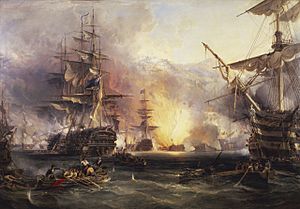 Bombardment of Algiers, 1816, George Chambers |
|||||||
|
|||||||
| Belligerents | |||||||
| Commanders and leaders | |||||||
| Units involved | |||||||
| Strength | |||||||
| 5 ships of the line 10 frigates (5 Dutch) 1 corvette 8 sloops 4 bomb ketchs 1 aviso |
17,000 soldiers (including 11,000 Zouaves and 6,000 Janissaries), number of sailors unknown seaward-facing batteries of 224 cannon 4 frigates 5 corvettes 40 gunboats |
||||||
| Casualties and losses | |||||||
|
Britain: 887-900 dead and wounded, Netherlands: 13 dead, 52 injured Half of the Anglo-Dutch fleet severely damaged |
500-5,000 total military and civilian casualties (including 300-2000 killed) 4 frigates destroyed 5 corvettes destroyed 28 gunboats sunk 12 gunboats beached |
||||||
| 3000 European slaves freed | |||||||
The Bombardment of Algiers happened on August 27, 1816. It was an effort by Britain and the Netherlands to stop the practice of slavery in Algiers. At that time, Omar Agha was the ruler, known as the Dey, of Algiers.
An Anglo-Dutch naval fleet, led by Admiral Edward Pellew, 1st Viscount Exmouth, attacked ships and port defenses in Algiers.
For a long time, European and American navies had been trying to stop piracy by North African states. These states were known as the Barbary states. The main goal of this attack was to free Christian slaves and stop Europeans from being enslaved. It was somewhat successful. After the attack, the Dey of Algiers freed about 3,000 slaves. He also signed a treaty against the enslavement of Europeans. However, this practice did not fully end until the French conquest of Algeria much later.
Contents
Why the Attack Happened
After the Napoleonic Wars ended in 1815, the Royal Navy no longer needed the Barbary states for supplies. This allowed Britain to push these states to stop their piracy and enslavement of European Christians.
In early 1816, Admiral Exmouth went on a diplomatic trip. He visited Tunis, Tripoli, and Algiers. He had a small group of warships with him. His goal was to convince the rulers to stop slavery and free Christian slaves.
The rulers of Tunis and Tripoli agreed easily. But the Dey of Algiers was more difficult. The talks were tense. Exmouth thought he had made a deal to end Christian slavery and went back to England.
However, due to mixed-up orders, Algerian soldiers killed 200 fishermen. These fishermen were from Corsica, Sicily, and Sardinia. They were under British protection. This happened right after the treaty was signed. This event caused great anger in Britain and Europe. Exmouth's negotiations were then seen as a failure.
Because of this, Exmouth was ordered to go back to Algiers. His mission was to finish the job and punish the Algerians. He gathered a group of ships. This included five large warships called ships of the line. There was also one 50-gun frigate and four regular frigates. Four bomb ships were also part of the fleet.
HMS Queen Charlotte, with 100 guns, was Exmouth's main ship. Rear Admiral David Milne was his second-in-command on HMS Impregnable, which had 98 guns. Many thought this force was not strong enough. But Exmouth had already secretly checked Algiers' defenses. He knew the city well and understood a weak spot in their cannons' firing range. He believed more large ships would get in each other's way.
Besides the main fleet, there were five smaller ships called sloops. There were also eight ships' boats armed with Congreve rockets. Some transport ships were also there to carry the freed slaves. When the British arrived in Gibraltar, a group of five Dutch frigates joined them. They were led by Vice-Admiral Theodorus Frederik van Capellen. Exmouth decided to have the Dutch ships protect the main force from Algerian side cannons. This was because there wasn't enough space for the Dutch frigates in the main harbor area.
Getting Ready for Battle
The day before the attack, a frigate named Prometheus arrived. Its captain, W. B. Dashwood, tried to secretly rescue the British Consul and his family. But some of the rescue team were caught and arrested.
The attack plan was for the larger ships to approach in a line. They would sail into an area where most of the Algerian guns could not hit them. Then, they would stop and fire at the cannons and forts in the harbor to destroy the defenses.
At the same time, HMS Leander, a 50-gun ship, would stop near the harbor entrance. It would fire at the ships inside the harbor. To protect Leander, the frigates HMS Severn and HMS Glasgow would sail closer to shore. They would fire at the shore cannons. Soldiers and engineers would then storm ashore on the harbor wall.
The Battle Begins
Exmouth, on Queen Charlotte, stopped about 80 meters (80 yards) from the harbor wall. He faced the Algerian guns directly. However, some other ships did not stop in the right place. Admiral Milne on HMS Impregnable was 400 yards away from where he should have been. This mistake made these ships less effective. It also exposed them to more intense Algerian fire. Some other ships sailed past Impregnable and stopped closer to the plan. The empty space left by Impregnable was filled by the frigate HMS Granicus and the sloop Heron.
Earlier, both Exmouth and the Dey of Algiers had agreed not to fire first. The Dey's plan was to let the fleet anchor. Then, he would send many men in small boats to board the British ships. But Algerian discipline was not as good. One Algerian gun fired a shot at 3:15 PM. Exmouth immediately started the attack.
The Algerian fleet of 40 gunboats tried to board Queen Charlotte. This happened while the sailors were busy setting the sails. But 28 of their boats were sunk by cannon fire from the British ships. The rest ran aground on the shore. After an hour, the cannons on the harbor wall were mostly silent. Exmouth then focused on the ships in the harbor. These were destroyed by 7:30 PM.
One Algerian frigate, which had no crew, was destroyed. Sailors from Queen Charlotte's small boat boarded it and set it on fire. Three other Algerian frigates and five corvettes were destroyed by bombs and rockets. The burning ships floating in the harbor forced some British ships to move out of the way.
Impregnable was separated from the other ships. It became a large and easy target. Algerian gunners focused on it, hitting it from front to back. The ship was badly damaged. It was hit 268 times in its hull. Its main mast was damaged in 15 places. 50 sailors were killed and 164 were wounded on board.
One sloop had been turned into an explosion vessel. It carried 143 barrels of gunpowder. At 8:00 PM, Milne asked for it to be used against the "Lighthouse battery." This battery was causing a lot of damage to his ship. The vessel was exploded, but it had little effect. It also exploded against the wrong battery.
Even with the damage, the Algerian cannons could not keep firing. By 10:15 PM, Exmouth ordered the fleet to raise anchor and sail away. HMS Minden stayed behind to keep firing and stop any more resistance. The wind had changed and was blowing from the shore, which helped the ships leave. By 1:30 AM the next morning, the fleet was anchored out of range.
The wounded were treated, and the crew cleaned up the damage. On the British side, more than 900 sailors were killed or wounded. This was a very high number of casualties. For example, at the Battle of Trafalgar, British casualties were only 9 percent of those fighting. The allied fleet fired over 50,000 cannonballs. They used 118 tons of gunpowder. The bomb ships fired 960 explosive mortar shells. The Algerian forces had 308 guns and 7 mortars.
The person who translated Exmouth's letter to the Dey saw the damage to the city. He went with the letter under a flag of truce. He said that the harbor wall could not be recognized. The places where the cannons had been were gone. Only four or five cannons were still visible. The bay was full of smoking remains of the Algerian navy. Many bodies were also floating in the water.
What Happened Next
Exmouth warned that if his terms were not accepted, he would continue the attack. The Dey accepted the terms. He did not know that Exmouth was bluffing. The fleet had already used almost all of its ammunition. A treaty was signed on September 24, 1816. The room where it was signed had been hit by nine cannonballs and was completely ruined.
The Dey freed 1,083 Christian slaves and the British Consul. He also paid back the ransom money taken in 1816, which was about £80,000. In total, over 3,000 slaves were freed later.
Historians note that this was one of the few times Britain lost many lives fighting to stop the slave trade. However, despite Britain's efforts, it is hard to know the long-term impact of the Bombardment of Algiers. The Dey rebuilt Algiers. He replaced Christian slaves with Jewish workers. The Barbary slave trade continued under future rulers. Algiers' involvement with the slave trade finally ended with the French invasion of Algiers in 1830.
More to Explore
- Algiers expedition (1541)
- Bombardment of Algiers (1683)
- Bombardment of Algiers (1784)
- Djidjelli expedition
- Invasion of Algiers (1775)
- Invasion of Algiers in 1830


